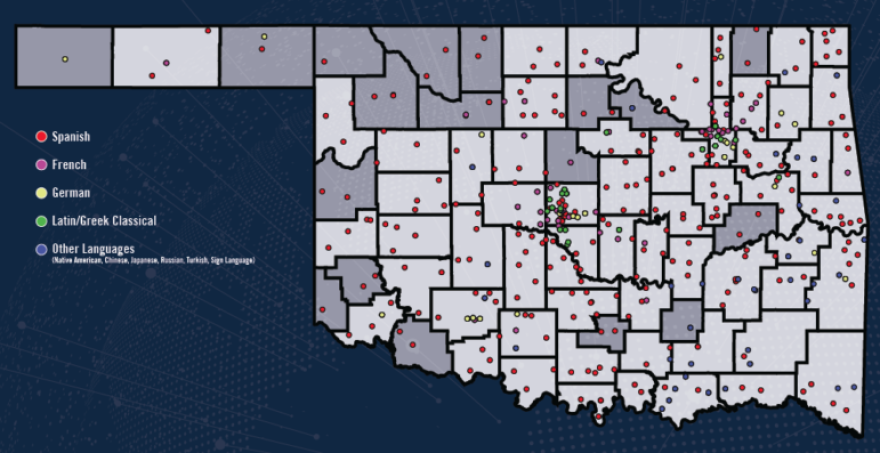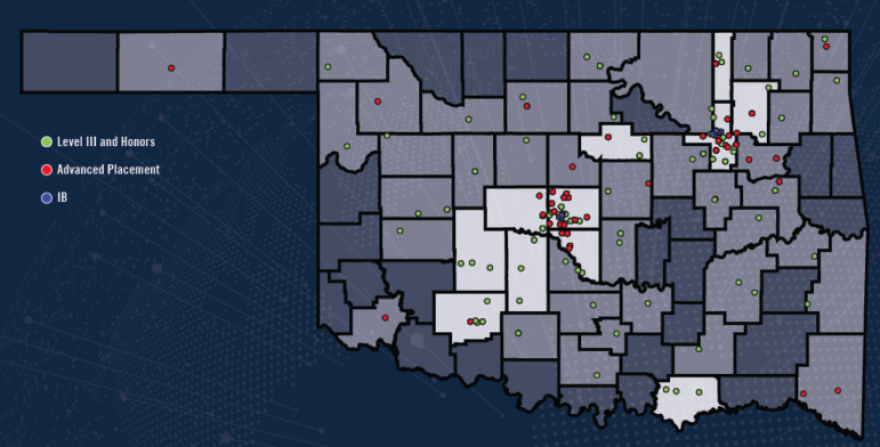A fourth of high schools across the state have eliminated world language classes over a decade, erasing the chances for thousands of students to acquire skills that could better prepare them for college and the job market.
The number of high schools without a single world language class has nearly quadrupled, from 39 in 2006 to 149 in 2016, according to an Oklahoma Watch analysis of data collected by the state Office of Educational Quality and Accountability. That means a third of Oklahoma high schools now don’t offer a single course.
A national study released in June by the American Councils for International Education found that 12 percent of Oklahoma students were enrolled in a world language course in 2014-15. (The term used to be foreign language.) That was below the national average of 20 percent and the seventh lowest rate in the country.
The trend has particularly hit rural areas.
Nearly all Oklahoma schools without world language classes have fewer than 300 students and are located in rural areas, indicating a significant divide in language education between rural and urban and suburban schools, where the most robust language programs are located.
To become proficient in a language, students require advanced-level courses, such as honors level, Advanced Placement or International Baccalaureate. But those classes are increasingly concentrated in the state’s urban areas, with a few exceptions.
In 40 of the state’s 77 counties, no schools offer an advanced-level world language class. That’s up from 27 counties a decade ago.

The state Department of Education is developing a program under its Every Student Succeeds Act plan to strengthen and expand learning of world languages. A separate initiative is aimed at alleviating one of the biggest reasons for the drop in second-language courses: a shortage of qualified teachers.
But reversing the downward trend will take money and buy-in.
No Requirement
Oklahoma, like most states, doesn’t require students to take a world language class to graduate.
The state offers two pathways to graduation. The college preparatory/work ready curriculum requires either two years of a world language or two years of computer technology. With a parent’s permission, a student can opt out and graduate with the core curriculum, which requires neither. (The state Department of Education doesn’t track how many students opt out.)
The state’s goal is for all students to have the opportunity to take a world language, said Desa Dawson, director of world languages education for the department. But without the option of computer science, students in rural areas would likely not have access to the courses they need to graduate.
Online instruction, which some high schools are using, is often not sufficient, she said. Sitting at a computer and repeating words and phrases in another language doesn’t meet state standards.
“It’s a little more challenging than other content areas because the number one goal is communication. You have to have immediate feedback,” Dawson said.
Learning a language is shown to have a host of advantages, including higher ACT scores and cognitive benefits, according to a 2017 report from the American Academy of Arts and Sciences’ Commission on Language Learning. And it’s a highly marketable and practical skill because of a growing demand for bilingual workers. U.S. employers’ job postings aimed at bilingual candidates more than doubled between 2010 and 2015.
Decline in Basic World Language Classes
These maps from the state Education Department show how the vanishing of Level II world language classes (the first two years) affects rural areas most of all. A decade ago, every county offered at least one world language class. Dots are colored by language; counties shaded medium gray have one or two schools with language courses; darkest shades indicate none.


A Need for Teachers
Oklahoma is facing an ongoing teacher shortage that has led to a record number of emergency certifications to fill spots. Certain subjects are especially hard hit, and those include special education, calculus and physics, and world languages.
“It’s a dire situation,” Dawson said of the lack of language teachers.
Salina High School, in the northeast corner of Oklahoma, is an example. The school used to offer Spanish and French, but the teachers retired years ago and haven’t been replaced, said principal Blake Crawford.
“We don’t have anybody that can teach it,” said Crawford, a first-year principal at the 268-student school. “It is one of those courses that is on my list to get back as soon as we can.” Adding a class in Cherokee or American Sign Language is also a possibility, Crawford added.
For now, students fulfill their graduation requirements with computer classes.
Dawson said the state has worked hard to alleviate the shortage.
One of the initiatives is an alternative pathway for teachers to become certified in Native American languages; there are now 10 tribal languages being taught in public schools for world language credit.
Decline in Advanced World Language Classes
These Education Department maps track the decline in advanced world language classes over a decade; many more counties offer only one class or none at all.


Getting into College
In contrast to the dwindling language classes in rural high schools, urban high schools like Tulsa Public Schools’ Booker T. Washington High School and Harding Charter Preparatory High School in Oklahoma City offer a variety of languages (like Spanish, Latin, Greek and German) at introductory and advanced levels.
Though colleges don’t tend to require foreign language study, students who have at least two years on their high school transcripts may have an edge when applying. Prestigious universities like Stanford recommend applicants have four years of the same world language in high school.
At the University of Oklahoma, almost all students who are accepted have at least two years of the same language, said Matt Hamilton, vice president and registrar of enrollment and student financial services.
“There is not a specific ‘plus’ factor for foreign language courses in high school,” he said. “The admissions committee views these courses as positive and important.”
Immersion Learning
At Southeast Elementary School in Jenks, students as young as kindergarten learn math and science in Chinese through a language immersion program. The school employs five Chinese teachers, one for each grade in kindergarten through fourth.
The program has expanded to two classes per grade since it began in 2010, and there’s typically a waiting list of about a dozen students, said principal Lindy Risenhoover.
“They are getting such a global perspective,” said Abbie Andrus, a teaching and learning specialist at the school. “When you only speak English, you are limited.”
The first group of students to go through the school’s immersion program are now eighth graders and are on track to take advanced-level Chinese in 10th grade.

Kinley Howard is a fourth-grade student in the Chinese partial immersion program at Southeast Elementary School in Jenks. Students spend half of the school day learning math and science in Chinese. Two sections in each grade – kindergarten through fourth grade – are offered at the school.
After Norman Public Schools cut funding for its popular French immersion program in 2016, parents applied for and received approval from the state Education Department to open a charter school in 2018.
Tulsa Public Schools has two dual-language magnet school programs for elementary students, at Zarrow International School and Dual Language Academy.
This demand for elementary-age language immersion programs jibes with research showing language exposure at a young age provides children the best chance of acquiring proficiency. Yet just 15 percent of public elementary schools in the U.S. offer a program for a non-English language, according to a 2016 American Academy of Arts and Sciences report.

From what Melanie Reynolds hears, students who start earlier than high school and push on have no regrets. The Spanish teacher at Ada Junior High School said former students who continued beyond two years of language tell her they’re glad they did.
“It’s useful in their jobs. It looks good on a resume,” she said. “It never has been as popular as it should be. People don’t seem to realize how important it is to be able to use another language.”
Programs of Excellence
As part of its education plan under the Every Student Succeeds Act, the state is developing a program to recognize schools that are strong in certain areas, including world languages.
Schools that achieve a Programs of Excellence designation will be eligible for federal grant dollars to encourage schools to start new or expand existing programs. The state has submitted the plan to the U.S. Department of Education, but it hasn’t yet been approved.
The state Education Department is expected to roll out Programs of Excellence beginning in 2018 with six categories: world languages, fine arts, math, science, social studies and safe and healthy schools.
Schools apply, and if certain criteria are met, can receive a gold, silver or bronze designation on the school report card.
“Schools feel as though their A through F score doesn’t tell the full story of what they’re doing in their school program,” said Levi Patrick, assistant director of curriculum and instruction for the state education department. “We want to provide a pathway for schools to tell that part of their story.”
Schools will be eligible for competitive grants of at least $50,000 in federal money in each category. The state expects to have $4 million annually for the program beginning in the spring. Oklahoma is one of a few states that proposed distributing these funds through a competitive grant process rather than a formula.
The program is still being finalized, but a sample rubric published with the state’s ESSA plan includes eleven elements in the world languages, among them student assessment, staff development, student enrollment and retention, and variety of languages.
“We are trying reset the way we think about education to get back to an appreciation for all that matters in a more holistic approach to education,” said state Superintendent of Public Instruction Joy Hofmeister.






